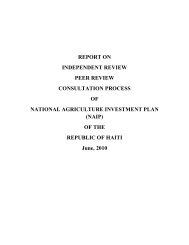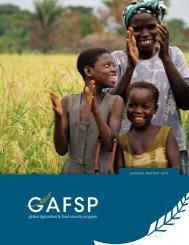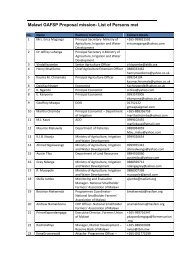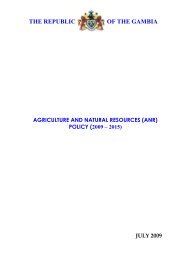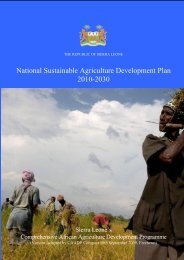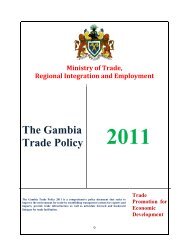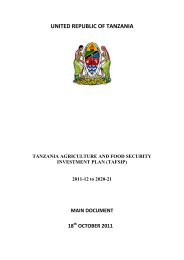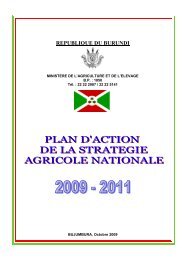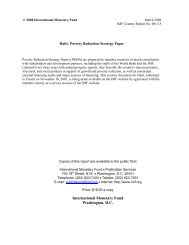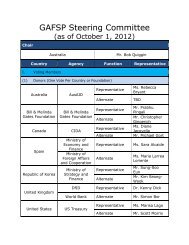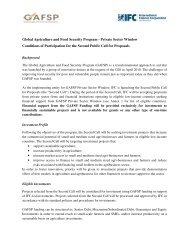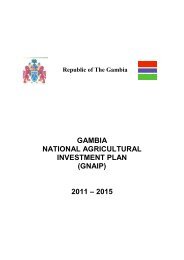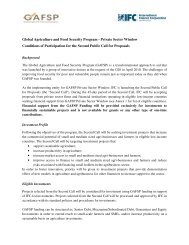World Bank Project Appraisal Document - GAFSP
World Bank Project Appraisal Document - GAFSP
World Bank Project Appraisal Document - GAFSP
Create successful ePaper yourself
Turn your PDF publications into a flip-book with our unique Google optimized e-Paper software.
28. The cost estimate covers (i) baseline contractor and supplier costs, (ii) engineering planning,<br />
design and construction supervision, and (iii) modest physical and price contingency allowances.<br />
Overall the mechanized and other works correspond to a rehabilitation cost of about $115 USD/ha and<br />
represent about 70% of the total rehabilitation cost. The overall budget for rehabilitation works under<br />
sub-components Ia and Ib is $32.49 million USD, equivalent to about $171 USD/ha over the improved<br />
irrigation area of about 190,000 ha.<br />
29. Sub-component Ic: Flood Channel Emergency Works (IDA financing of USD 3.34 million). The<br />
project will finance emergency restoration of a flood channel that traverses and protects the city of<br />
Kulyab as well as reduces risks for agriculture land and irrigation systems supported through the<br />
project down in Vose district.<br />
30. There is an urgent need to restore severely damaged flood protection works along a 5.7 kilometer<br />
reach of flood channel that passes through Kulyab city. Full resolution of the overall flood control<br />
problem would require attention not only to city flood channel works but also to upstream river and<br />
basin flood management systems, and would need to be based on prior comprehensive engineering<br />
studies. Such interventions would be beyond the capacity of the project to support. It was therefore<br />
agreed with MAWRM that provisions would be made for work on an emergency basis to restore the<br />
critical Kulyab city portion of the damaged flood channel.<br />
31. Available engineering designs, drawings, quantifications and cost estimates for the proposed<br />
flood channel restoration works are at a preliminary level. A proper, detailed engineering design phase<br />
corresponding to these works will therefore be needed in the first instance. This will cover studies to<br />
review and confirm technical options and solutions, site surveys and investigations as warranted,<br />
detailed designs, quantity and cost estimations, and preparation of drawings and tender documents for<br />
contracting of the works. Execution of the works under proper supervision and quality control with<br />
design support on an as-needed basis will then need to follow.<br />
32. The proposed project interventions for restoration of the flood channel therefore include (i)<br />
essential, prior, full detailed engineering planning and design studies, followed by (ii) well-managed<br />
execution of the designed works. The allocated budget of $3.36 million USD also includes allowances<br />
for (i) engineering construction supervision, (ii) reasonable physical contingencies, and (iii) modest<br />
price contingencies.<br />
33. Component II: Assistance in water resources management, including technical assistance<br />
for policy and institutional reform (total <strong>Bank</strong> funding of USD 8.07 million, of which USD 4.04<br />
million <strong>GAFSP</strong> funds and USD 4.03 million IDA funds). This component will finance technical<br />
assistance to the MAWRM and other relevant institutions to support the reform of water resource<br />
management. Transformation of the MAWRM into the Ministry of Water Resources will receive<br />
particular support, with the aim to facilitate its leadership of the reform process. <strong>Project</strong> support for<br />
consultation, stakeholder participation and consensus building will be critical in this context, to<br />
facilitate its role as the convenor of stakeholders in water resource management. Reform will be based<br />
on the following principles: (i) the separation of water resource management and water service<br />
delivery; (ii) the associated separation of policy making and planning from operational management of<br />
the sector; and (iii) the introduction of Integrated Water Resource Management (IWRM), organized<br />
27



